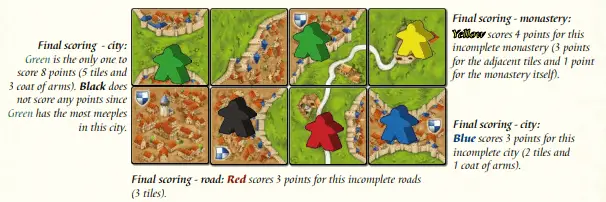Simple to Read Carcassonne Rules
Quick reference and simple to read Carcassonne rules. We cover the essential instructions and directions to get your game started quickly.
Players: 2 to 5 | Game duration from: 30 mins | Game Complexity: EASY How to play Carcassonne rules in simple steps | Play Carcassonne Online Link 1 Play Carcassonne Online Link 2
What are the rules of Carcassonne?
Carcassonne is a tile-placement, territory-building game centred around the world-famous French city, known for its fortifications erected during the Middle Ages. Players build the area surrounding Carcassonne and place their followers onto roads and into cities, monasteries, and fields.
Players take turns to place tiles, representing landscapes of roads, cities, monasteries, and fields. Meeples placed on these tiles become highwaymen, knights, monks, and farmers and allow players to score as many points as possible. Points are also earned at the very end and the highest scorer at the end is the winner.
Game setup
Land Tiles
- There are 84 land tiles which depict:
- roads
- cities
- monasteries

Land tiles with Rivers
- Twelve (12) of these tiles show a river.
- Every tile shares the same back, with the exception of the start tile and the twelve River tiles. The back of those tiles is darker, making them easy to set them aside.

Placing the Starting Tile
- Place starting tile (the one with a dark back) in the middle of the table.
- Shuffle the remaining tiles and set them as different facedown stacks that are easily accessible to all players.
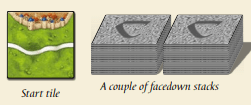
Scoreboard and Meeples
- Put to the scoreboard to the side of your playing surface (table, floor, etc.)
- There are 40 regular meeples (8 meeples in each of these colours: yellow, red, green, blue, and black)
- There are also 5 abbots (1 in each of the same colours)
- Each player chooses a colour and gets 7 meeples of the colour as personal supply
- Each player will take the remaining meeple in their color and sets it
on space 0 of the scoreboard. - Return to the box any unused meeples and, for newcomers, the abbots
- Select a first player
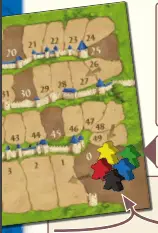
Carcassonne board game rules – Gameplay
Players take turns in clockwise order. Each player takes the following actions to try to complete and own features (Roads, Cities, Monasteries) on their landscape.
- Place a tile
- The player draws exactly 1 Land tile from a stack
- The player places it faceup and continues the landscape
- Place a meeple
- The player may a meeple from their supply onto the recently placed tile
- Score a feature
- The player must score any feature completed by their tile placement.
Placing Road Tiles and Scoring Road Features
Placing a tile
When drawing a road tile, you must place it such that it continues the existing landscape (the tiles already in play)

Placing a meeple on a road
- Once a road tile is placed, you may place a meeple as a highwayman on one of the road’s segments
- The road segment must be unoccupied by another highwayman
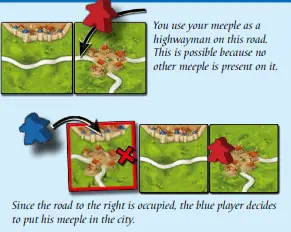
Scoring a road
- A road is completed and scored when both ends are closed.
- The end of a road is closed when it meets a village, a city, a monastery, or it loops onto itself by meeting the other end
- If another player places a tile to close a road and it completes your road, you will still score points.
- How many points do you score? When scoring a road, each tile of that road grants you 1 point. Once scored, return the highwayman meeple to your supply
- Move your meeple on the scoreboard by the number of points

Placing City Tiles and Scoring City Features
Placing a tile
- Tiles are drawn to continue the landscape
- Illustration of tiles must be continued. For example, a city segment must be connected to an open city.

Placing a meeple as a knight
- You can place a meeple as a Knight in the city if there isn’t already one.
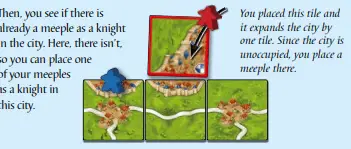
Scoring a city
- When you complete a city feature, it must now be scored.
- A completed city is surrounded by walls and there are no gaps inside the city
- If you have a meeple in the completed city, you are the player to score it
- Each tile in a completed city is worth 2 points. In addition, each knight is worth 2 more points. Once scored, the meeple that was in the scored feature (knight) returns to your supply.
- Move your meeple on the scoreboard by the number of points
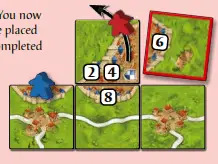
Placing Monastery Tiles and Scoring Monastery Features
Placing a tile
- Once a tile is drawn, continue the landscape
- Monasteries are illustrated in the centre of a tile

Placing a meeple as a monk
- You can place a meeple from your supply on a monastery as a monk
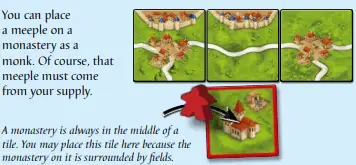
Scoring a monastery
- A monastery is completed when it is surrounded by tiles.
- Once completed, you will score the monastery feature. The feature is worth 1 point per tile that completes it (including the monastery itself).
- Once completed, as usual, you to take your meeple back.
- Move your meeple on the scoreboard by the number of points
Multiple meeples in the same feature
Here are some scenario examples that result in multiple meeples in the same feature.
Scenario 1: Multiple players scoring the same road feature
- You draw a road tile and have the option to continue the road.
- There is already a highwayman on that road, which means that you may not place yours.
- You place your tile, and a highwayman, in a space that is not connected.
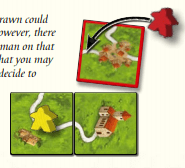
- In following turns, you draw this tile and decide to continue the road with it.
- Both roads, each with a highwayman, are now connected.
- The road is completed and both you and the other player score 4 points.
- Then, you both take your meeple back.

Scenario 2: Controlling a city feature with multiple meeples
- You wish to take control of the city away from yellow and place your
tile as pictured with a knight on it. - You are allowed to place a knight there because the city segment is not connected to another city segment with a knight on it.
- If you succeed in linking your two city segments, your two knights will allow you to take the city from yellow.
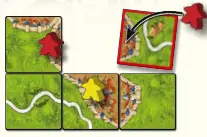
- You place the tile you needed to connect the city segments.
- Since you now have the most knights in the city, only you get to score the 10 points awarded for completing that city.
- Then, both you and the other player take back your meeples.
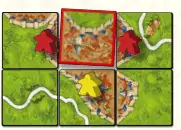
How do you win?
End of game
The game ends after the turn of the player who placed the last tile. Once the game is over, all meeples still in play are scored.
Carcasonne scoring
| Scoring post game | Points |
|---|---|
| Incomplete road | 1 point per tile |
| Incomplete city | 1 point per tile |
| Incomplete monastery | 1 point per tile plus adjacent tile |
| Field (also used for games involving farmers and fields) | 3 points per adjacent completed city |
Farmers are presented in the supplementary rules. It is recommended to play a few games before introducing farmers and fields.
